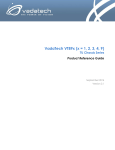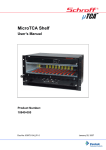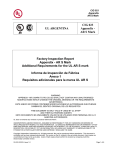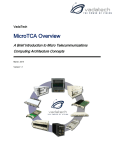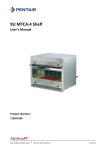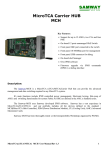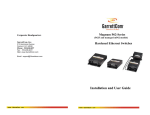Download VadaTech VT88x User Manual
Transcript
VadaTech VT88x (0,1 series) User Manual February 12, 2011 Version 1.0 THE POWER OF VISION VadaTech VT88x User Manual Copyright © 2011 VadaTech Incorporated All rights reserved VadaTech and the globe image are trademarks of VadaTech Incorporated. All other product or service names mentioned in this document are the property of their respective owners. Notice While reasonable efforts have been made to assure the accuracy of this document, VadaTech, Inc. assumes no liability resulting from any omissions in this document or from the use of the information obtained herein. VadaTech reserves the right to revise this document and to make changes periodically and the content hereof without obligation of VadaTech to notify any person of such revision or changes. Electronic versions of this material may be read online, downloaded for personal use, or referenced in another document as a URL to the VadaTech Incorporated Web site. The text itself may not be published commercially in print or electronic form, edited, translated, or otherwise altered without the permission of VadaTech, Inc. It is possible that this publication may contain reference to or information about VadaTech products (machines and programs), programming, or services that are not available in your country. Such references or information must not be construed to mean that VadaTech intends to announce such products, programming, or services in your country. Trademarks The VadaTech, Inc name and logo are registered trademarks of VadaTech Incorporated in the U.S.A. All other product or service names mentioned in this document are the property of their respective owners. © 2011, VadaTech Incorporated. Printed in the U.S.A., All Rights Reserved. Page 2 of 25 VT-MAN-CUS-100303 VADATECH FORM No. 3WI731-01 Rev. B VadaTech VT88x User Manual Revision History Doc Rev 1.0 Page 3 of 25 Description of Change Document Created Revision Date 02/12/2011 VT-MAN-CUS-100303 VADATECH FORM No. 3WI731-01 Rev. B VadaTech VT88x User Manual Table of Contents Overview ................................................................................................................................. 7 1.1 Document References ................................................................................................... 7 1.2 Acronyms Used in this Document ................................................................................. 7 2 Components ........................................................................................................................... 8 2.1 Slot Layout ...................................................................................................................... 8 2.2 Power Modules ............................................................................................................... 9 2.2.1 Sensors ................................................................................................................... 9 2.2.2 LEDs ......................................................................................................................10 2.3 Cooling Units ................................................................................................................10 2.3.1 Fan Trays ..............................................................................................................11 2.3.1.1 Fan Tray Replacement .................................................................................12 2.3.2 Air Filter Replacement .........................................................................................12 2.4 Telco Alarm Module .....................................................................................................13 2.4.1 FRU Information ...................................................................................................14 2.4.2 Chassis Locator ....................................................................................................14 2.4.3 Carrier Locator Switch Logic................................................................................14 2.5 JTAG Module .................................................................................................................15 2.5.1 JSM Switches .......................................................................................................15 2.5.2 JSM Module LEDs ................................................................................................16 2.5.3 JTAG Backplane Topology ....................................................................................16 2.6 Clock Options ...............................................................................................................17 2.7 Backplane Topology .....................................................................................................17 2.7.1 IPMB Busses ........................................................................................................18 2.7.2 Ports 0 and 1 ........................................................................................................18 2.7.3 Ports 2 and 3 ........................................................................................................19 2.7.4 Ports 4 – 7 and 8 – 11 ........................................................................................20 3 Appendices ...........................................................................................................................21 3.1 VT880 ...........................................................................................................................22 3.1.1 Components .........................................................................................................22 3.1.2 Power Supplies .....................................................................................................22 3.1.2.1 Command Line Interface .............................................................................22 3.1.3 Fan Trays ..............................................................................................................23 3.2 VT881 ...........................................................................................................................24 3.2.1 Components .........................................................................................................24 3.2.2 Power Supplies .....................................................................................................24 3.2.2.1 Command Line Interface .............................................................................24 3.2.3 Fan Trays ..............................................................................................................25 1 Page 4 of 25 VT-MAN-CUS-100303 VADATECH FORM No. 3WI731-01 Rev. B VadaTech VT88x User Manual Figures Figure 1: Typical Front View for VT88x Cassis............................................................................. 7 Figure 2: VT88x Slot Layout (Front View). Cooling Units not shown. ......................................... 8 Figure 3: Typical Fan Tray Front Panel ......................................................................................11 Figure 4: Fan Tray Extraction......................................................................................................12 Figure 5: Air Filter Location and Assembly ................................................................................13 Figure 6: DA232 Front Panel......................................................................................................14 Figure 7: DA232 Chassis Locator Switches ..............................................................................14 Figure 8: JSM Module Front Panel.............................................................................................15 Figure 9: VT88x Topology for AMC JTAG Signals.......................................................................17 Figure 10: VT88x non-redundant clock topology, CLK3 can run as Fabric Clock (e.g. PCIe clock).............................................................................................................................................17 Figure 11: VT88x AMC I2C bus topology. ..................................................................................18 Figure 12: VT88x AMC Port 0 and 1 Topology. .........................................................................18 Figure 13: VT88x AMC Port 2 and 3 Topology for Ordering Options 1 and 0. ........................19 Figure 14: VT88x AMC Ports 4-7 and 8-11 Topology. ..............................................................20 Figure 15: VT880 Layout. ...........................................................................................................22 Figure 16: VT880 Integrated PM’s RS-232 Connector. ...........................................................23 Figure 17: VT881 Layout. ...........................................................................................................24 Figure 18: VT881 Integrated PM’s RS-232 Connector. ...........................................................25 Page 5 of 25 VT-MAN-CUS-100303 VADATECH FORM No. 3WI731-01 Rev. B VadaTech VT88x User Manual Tables Table 1: Model Comparison Chart ............................................................................................... 7 Table 2: Acronyms......................................................................................................................... 7 Table 3: AMC Slot Numbering ...................................................................................................... 8 Table 4: VT88x’s PM Sensors....................................................................................................... 9 Table 5: VT88x PM Front Panel LEDs. .......................................................................................10 Table 6: Cooling Units .................................................................................................................10 Table 7: Common Cooling Unit Sensors ....................................................................................11 Table 8: Cooling Unit LEDs .........................................................................................................12 Table 9: Carrier Number Configuration .....................................................................................15 Table 10: Slave Select LEDs ......................................................................................................16 Table 11: MGNT LEDs.................................................................................................................16 Page 6 of 25 VT-MAN-CUS-100303 VADATECH FORM No. 3WI731-01 Rev. B VadaTech VT88x User Manual 1 Overview Figure 1: Typical Front View for VT88x Cassis. The VT88x series, shown in Figure 1, are 2U MicroTCA Carriers offering a variety of chassis, AMC and MCH configurations. Current production comprises VT88x models x=[0 1]. This document describes the common VT88x chassis, configuration and operation. Attached Appendices describe each model’s individual characteristics with configuration and operational characteristics. Table 1 provides shows a comparison chart for each model’s features. Model # of MCH Slots VT880 VT881 2 2 # of Power Module slots 2 2 JSM Telco Alarm Yes Yes Yes Yes # of AMC FH Slots 4 4 # of AMC MH Slots 8 8 # of AMC CH Slots 0 0 Table 1: Model Comparison Chart 1.1 1.2 Document References PICMG Specification MTCA.0 R1.0 (MicroTCA) VadaTech VT880 data sheet VadaTech VT881 data sheet Acronyms Used in this Document Acronym AMC CU JTAG MCH PM FH MH CH Description Advanced Mezzanine Card Cooling Unit Joint Test Action Group MicroTCA Carrier Hub Power Module Full Height Mid Height Compact Height Table 2: Acronyms Dual Redundant Fan Tray Type of Power Input Redundant Power Modules Yes Yes AC DC Yes Yes VadaTech VT88x User Manual 2 Components The VT88x carrier’s components include redundant Power Entry Modules, two Cooling Units, temperature sensors, a JTAG Switch Module (JSM), and a removable Telco Alarm Interface board. The removable Telco Alarm Board contains the Carrier Locator and Carrier FRU Information devices. Unlike other MicroTCA chassis in the market, the VT88x Models have no active components on its backplane, for ease of serviceability. The VT88x carriers are designed for a Right-To-Left airflow and are equipped with removable Fan Trays on both intake and outtake sides of the chassis. 2.1 Slot Layout The VT88X carriers share the same Slot layout, shown in Figure 2. Figure 2: VT88x Slot Layout (Front View). Cooling Units not shown. Slot 1 2 3 4 5 6 7 8 9 10 11 12 IPMB-L Address 0x72 0x74 0x76 0x78 0x7A 0x7C 0x7E 0x80 0x82 0x84 0x86 0x88 FRU 5 6 7 8 9 10 11 12 13 14 15 16 Table 3: AMC Slot Numbering Page 8 of 25 VT-MAN-CUS-100303 VADATECH FORM No. 3WI731-01 Rev. B VadaTech VT88x User Manual 2.2 Power Modules For Power Module faceplate and connector information, see the model-specific sections in the appendix. 2.2.1 Sensors Each VT88x PM provides the following sensors: Number 0x10 0x11 0x12 0x13 0x14 0x28 0x90 0x91 0x94 0x95 Type 0x01 0x01 0x01 0x01 0x01 0x02 0xF2 0xF1 0x08 0xF3 Name PM tCRIT1 PM tCRIT2 PM tCRIT3 PM tIN PM tOUT 88x PM 12V PM HOT SWAP VT88x IPMB PM STATUS PM NOTIFICATION 0x96 0x97 0xA0 0xA1 0xA2 0xA3 0xA4 0xA5 0xA6 0xA7 0xA8 0xA9 0xAA 0xAB 0xAC 0xAD 0xAE 0xAF 0x08 0xC0 0x03 0x03 0x03 0x03 0x03 0x03 0x03 0x03 0x03 0x03 0x03 0x03 0x03 0x03 0x03 0x03 88x PM PWR IN FPGA Version AMC 1 Current AMC 2 Current AMC 3 Current AMC 4 Current AMC 5 Current AMC 6 Current AMC 7 Current AMC 8 Current AMC 9 Current AMC 10 Current AMC 11 Current AMC 12 Current MCH 1 Current MCH 2 Current CU 1 Current CU 1 Current Description FET or Brick temperature, depending on AC/DC FET or Brick temperature, depending on AC/DC FET or Brick temperature, depending on AC/DC Incoming Air Temperature (Out on PM 2) Outgoing Air Temperature (In on PM 2) 12V DC Power Output AMC Hot Swap Handle ATCA IPMB-0 Status MicroTCA Power Module Status MicroTCA Power Module Notification (Event-Only) Input Power Redundancy OEM FPGA Version sensor AMC 1 Current Draw AMC 2 Current Draw AMC 3 Current Draw AMC 4 Current Draw AMC 5 Current Draw AMC 6 Current Draw AMC 7 Current Draw AMC 8 Current Draw AMC 9 Current Draw AMC 10 Current Draw AMC 11 Current Draw AMC 12 Current Draw MCH 1 Current Draw MCH 2 Current Draw Cooling Unit 1 Current Draw Cooling Unit 2 Current Draw Table 4: VT88x’s PM Sensors Page 9 of 25 VT-MAN-CUS-100303 VADATECH FORM No. 3WI731-01 Rev. B VadaTech VT88x User Manual 2.2.2 LEDs The LEDs on the front panel indicate the state of the PM. Group ATCA LED Name Hot Swap Fault Color Blue Red OK Green Upgrade Amber Description Indicates PM hot-swap state, per AMC.0 ON when PM cannot provide power on any power channels. Reflects the state of PM_OK, per MicroTCA. This usually indicates a recoverable fault. For example, input power is not present, or the PM is over temperature. ON when PM is operating normally. This LED will be ON when the Fault LED is OFF, and vice versa. This LED blinks during operations that modify the firmware configuration. This includes SDR and FRU writes, and HPM.1 upgrade operations. The PM should not be removed or turned off while this LED is blinking. Table 5: VT88x PM Front Panel LEDs. Some Power Modules allow two redundant power sources to be connected to the PM. Note that if only one power source is active, the -48V RET LED will blink. This indicates that the input power is not redundant, and is not a fault condition. 2.3 Cooling Units The VT88X carrier includes two redundant MicroTCA Cooling Units (CUs), as shown in the following table. Position Right Left CU1 CU2 Name Power Channel 3 4 IPMB Address 0xA8 0xAA 40 41 FRU ID Table 6: Cooling Units The right unit is considered the intake air unit and the left unit considered the exhaust air unit. A chassis air filter is located before the right unit. Page 10 of 25 VT-MAN-CUS-100303 VADATECH FORM No. 3WI731-01 Rev. B VadaTech VT88x User Manual The Cooling Units provide the following sensors: Number 0x10 0x33 0x48 0x49 0x4A 0x4B 0x4C 0x4D 0x30 0x31 0x32 0x3E 0x90 0x91 0x3F Type 0x01 0x01 0x04 0x04 0x04 0x04 0x04 0x04 0x01 0x01 0x01 0xD7 0xF2 0xF1 0xF4 Name VT 88x CU T1 VT 88x CU T2 FAN1 RPM FAN2 RPM FAN3 RPM FAN4 RPM FAN5 RPM FAN6 RPM VT 88x CU T3 VT 88x CU T4 VT 88x CU T5 TELCO ACTIVE VT 880 CU HS VT 880 CU IPMB TELCO ALARM Description Temperature (LM75) Temperature (ADT 7462 internal) RPM RPM RPM RPM RPM RPM Temperature (ADT 7462 external) Temperature (ADT 7462 external) Temperature (ADT 7462 external) Telco Alarm support sensor AMC Hot Swap Handle ATCA IPMB-0 Status Telco Alarm Status Table 7: Common Cooling Unit Sensors 2.3.1 Fan Trays Each Fan Tray provides four LEDs, a hot swap button, and a Latching screw to allow for locking and removal of the fan tray, as shown in Figure 3. Figure 3: Typical Fan Tray Front Panel The LEDs indicate the state of the CU, as described in the following table. Name Hot Swap Fail Page 11 of 25 Color Blue Red Description indicates hot-swap state, per AMC.0 and MicroTCA specifications ON indicates failure. For example, the geographic address pins are invalid, or payload power has failed. BLINKING indicates that one or more fans have stalled, or are still spinning up. OFF indicates normal operation. VT-MAN-CUS-100303 VADATECH FORM No. 3WI731-01 Rev. B VadaTech VT88x User Manual OK Upgrade Green Amber ON indicates normal operation. ON while the CU operation is interrupted during a firmware upgrade. Table 8: Cooling Unit LEDs At power-on, the hot swap handle state is Closed. Pushing the Hot Swap button once toggles the handle state to Open. Pushing the Hot Swap button again toggles the handle state to Closed. See Appendix for model-specific information for location and quantity of Removable Fan Trays. 2.3.1.1 Fan Tray Replacement A fan tray must be replaced if any of its fans fail. Fan trays may also be replaced if more powerful or more efficient fans become available. Fan trays may be replaced during chassis operation, with two limitations. First, do not touch the fan blades when taking the fan tray out of the chassis. Second, put the new fan tray into the chassis quickly to prevent overheating. Figure 4: Fan Tray Extraction The mechanism used on all VT88x chassis uses a captive screw with a retention tab. Normally, the tab is pointing downward, as shown in Figure 4. Loosen the screw until the tab points to the right. Then pull on the screw to take the fan tray out of the chassis. To put a new fan tray into the chassis, make sure the tab is pointing to the right. Push the fan tray firmly into the chassis, then firmly hand-tighten the screw. The tab should be pointing down. 2.3.2 Air Filter Replacement The chassis air filter must be replaced if dust has accumulated in the filter, reducing the cooling capacity of the chassis. The air filter may be replaced during normal chassis operation. The air filter is held in place by two captive screws, as shown on Figure 5. Loosen the screws, and then pull on the air filter to remove it from the chassis. Put the new air filter into the chassis, then firmly hand-tighten the screws. Page 12 of 25 VT-MAN-CUS-100303 VADATECH FORM No. 3WI731-01 Rev. B VadaTech VT88x User Manual Figure 5: Air Filter Location and Assembly 2.4 Telco Alarm Module The VT88x series use the DA232 as the Telco Alarm Interface. The Telco Alarm Connector is used to relay alarm information to an external alarm device. The “ACT 0” and “ACT 1” LEDs indicate which Cooling Unit is representing the Telco device to the Carrier Manager. Normally, “ACT 0” will be on, indicating that the right CU is active. The Critical (CRIT), Major (MAJ), and Minor (MIN) Alarm LEDs indicate the state of the alarms. When an alarm is active, the corresponding LED will be on. The Chassis Power Switch (PWR) is used to send a “Chassis Control” request to the Carrier Manager. This will cause a controlled power-down (or power-up) of all of the FRUs in the Carrier. The Power Button LED (OFF) reflects the state of the “Chassis Power Switch”. The Power Good LED (PGD) reflects the power state of the DA232. The Telco Alarm Cutoff button (ALARM RESET) is used to engage the Telco Cutoff, turning off the external Telco alarms. The alarm LEDs will not change, but the external alarm device, if any, will be turned off. The Telco Cutoff can be disengaged using the Set Telco Alarm State ATCA Command. When disengaged, the external Telco alarms will turn back on. Page 13 of 25 VT-MAN-CUS-100303 VADATECH FORM No. 3WI731-01 Rev. B VadaTech VT88x User Manual Figure 6: DA232 Front Panel 2.4.1 FRU Information There are two EEPROMs on the module that is used to store the Carrier FRU information. Both the EEPROMs are located at address 0x52 and accessible by each MCH respectively. 2.4.2 Chassis Locator Chassis locator switches on the DA232 module are shown in Figure 7. The chassis locator switches can be configured to provide a carrier number ranging from 1..16 as shown in Table 9. Figure 7: DA232 Chassis Locator Switches 2.4.3 Carrier Locator Switch Logic If multiple Carriers are configured with an external Shelf Manager, make sure that each Carrier has a unique Carrier number. To set the Carrier number for the VT88X, set the Chassis Locator switches on the Telco Alarm Module (DA232) according to Table 9. Make sure both the MCH1 and MCH2 switches are set the same. Page 14 of 25 VT-MAN-CUS-100303 VADATECH FORM No. 3WI731-01 Rev. B VadaTech VT88x User Manual The Table shows switch positions to set Carrier number. Carrier Number 1 2 3 4 5 6 7 8 9 10 11 12 13 14 15 16 On On On On On On On On Off Off Off Off Off Off Off Off Switch 1 On On On On Off Off Off Off On On On On Off Off Off Off Switch 2 On On Off Off On On Off Off On On Off Off On On Off Off Switch 3 Switch 4 On Off On Off On Off On Off On Off On Off On Off On Off Table 9: Carrier Number Configuration 2.5 JTAG Module The Models in the VT88X Series have a JTAG Switch Module (JSM) interface which provides JTAG support to all JTAG-capable Modules in the system. The front connector is a standard 0.1 header which mates to most JTAG modules. There are three Arbitrated Master ports (2 MCH and the front/rear connector). The secondary ports are auto-detected if they are present. The module provides transparent communication between the Master and a selected secondary port. All configuration modes use an IEEE1149.1 TAP controller. The JTAG can operate with a clock up to 50MhZ. Figure 8: JSM Module Front Panel 2.5.1 JSM Switches The FTM REQ switch is used to request JTAG Master access for the front connector. The CFG switch allows configuration of the JTAG switch to occur through the front connector. The RST switch resets the JTAG switch. Page 15 of 25 VT-MAN-CUS-100303 VADATECH FORM No. 3WI731-01 Rev. B VadaTech VT88x User Manual 2.5.2 JSM Module LEDs The ACT LED indicates that the JSM is active. The Slave Select LEDs indicate which secondary port is selected. If no LEDs are on, no secondary port is selected. Otherwise, add the numbers next to the illuminated LEDs together and use the following table. Value 1 2 3 4 5 6 7 8 9 10 11 12 13 14 15 16 JTAG Target AMC 1 AMC 2 AMC 3 AMC 4 AMC 5 AMC 6 AMC 7 AMC 8 AMC 9 AMC 10 AMC 11 AMC 12 CU 1 CU 2 PM 1 PM 2 Table 10: Slave Select LEDs The MGNT LEDs indicate which master is currently granted access. If no LEDs are on, no master has access. 0 1 2 LED JTAG Master Front Panel or Rear Connector MCH 1 MCH 2 Table 11: MGNT LEDs The DPDV LED directly indicates the state of the DPDV bit in the Device Configuration Register. 2.5.3 JTAG Backplane Topology The JSM Module is fully connected point-to-point with each AMC as shown in Figure 9. Page 16 of 25 VT-MAN-CUS-100303 VADATECH FORM No. 3WI731-01 Rev. B VadaTech VT88x User Manual Figure 9: VT88x Topology for AMC JTAG Signals 2.6 Clock Options The VT88x series provide non-redundant clock networks connecting MCH clocks CLK1, CLK2 and CLK3 to the AMC clocks CLK1, CLK2 and CLK3 by a dedicated line (Shown in Figure 10). CLK3 can be assigned a Telco clock or become the Fabric clock per AMC.1 specification. Fabric B will be partially provided on ports 1 – 6 and CLK6 is routed to Fabric B on ports 1 – 12. Redundant options connect CLK1 of MCH1 point-to-point to each AMC CLK1 and CLK1 of MCH2 point-to-point to each AMC CLK3. (See Appendix for model-specific redundant clock information.) a Figure 10: VT88x non-redundant clock topology, CLK3 can run as Fabric Clock (e.g. PCIe clock). 2.7 Backplane Topology Common VT88x backplane connectivity is shown here. Page 17 of 25 VT-MAN-CUS-100303 VADATECH FORM No. 3WI731-01 Rev. B VadaTech VT88x User Manual Depending on the clock options selected, some fabrics may not be routed. Refer to the VT88x data sheet for details. 2.7.1 IPMB Busses The VT88x provides a dual-redundant IPMB-0 bus among the MCH1, MCH2, CU1, CU2, PM1, and PM2 modules. The IPMB-L is a radial dual-star with each MCH connected to all AMCs as shown in Figure 11. Figure 11: VT88x AMC I2C bus topology. 2.7.2 Ports 0 and 1 MCH1 Fabric A is connected to port 0 on all of the AMCs and MCH2 Fabric A is connected to port 1 on all AMCs as shown in Figure 12. Figure 12: VT88x AMC Port 0 and 1 Topology. Page 18 of 25 VT-MAN-CUS-100303 VADATECH FORM No. 3WI731-01 Rev. B VadaTech VT88x User Manual 2.7.3 Ports 2 and 3 AMC ports 2 and 3 (SAS / SATA) are routed depending on the ordering option. Under option 1, AMCs are connected directly together (See Appendix for model-specific information). Under option 0, MCH1 Fabric B is connected to port 2 on all of the AMCs, and MCH2 Fabric B is connected to port 3 on all of the AMCs as shown in Figure 13. Figure 13: VT88x AMC Port 2 and 3 Topology for Ordering Options 1 and 0. Page 19 of 25 VT-MAN-CUS-100303 VADATECH FORM No. 3WI731-01 Rev. B VadaTech VT88x User Manual 2.7.4 Ports 4 – 7 and 8 – 11 In the fat pipes region, MCH1 Fabrics D, E, F, and G are connected to ports 4, 5, 6, and 7, respectively, on all AMCs. MCH2 Fabric D, E, F, and G are connected to ports 8, 9, 10, and 11, respectively, on all AMCs as shown in Figure 14. Figure 14: VT88x AMC Ports 4-7 and 8-11 Topology. Page 20 of 25 VT-MAN-CUS-100303 VADATECH FORM No. 3WI731-01 Rev. B VadaTech VT88x User Manual 3 Appendices The Appendices contain model-specific information for each product followed by configuration information and tables. Appendix 3.1 – Model VT880 Appendix 3.2 – Model VT881 Page 21 of 25 VT-MAN-CUS-100303 VADATECH FORM No. 3WI731-01 Rev. B VadaTech VT88x User Manual 3.1 VT880 3.1.1 Components The layout and module locations for the VT880 are shown in Figure 15. Figure 15: VT880 Layout. 3.1.2 Power Supplies The VT880 is an AC-Only Chassis and it will take a universal AC input, 110-240VAC @ 4763Hz per Power Supply. Due to its redundancy capabilities, the VT880 comes with a TOP and BOTTOM Power Supply tray. Both Power Supplies are fully removable and can be Field-Replaced if needed. Each Power Supply includes an integrated MicroTCA PM. The Power Entry Module (PEM) FRU Inventory is read when the power is first turned on to determine the PM power capability. At power-on, the hot swap handle state is Closed. Pushing the Hot Swap button once toggles the handle state to Open. Pushing the Hot Swap button again toggles the handle state to Closed. 3.1.2.1 Command Line Interface The integrated PM implements a Command Line Interface (CLI) to provide power and temperature status independently of the MCH. Access to this interface is provided by the serial RS232 port on the main panel (PM RS-232). The serial port is a female micro-USB connector, as shown on Figure 16. To connect this serial port to a standard DB9 connector, Page 22 of 25 VT-MAN-CUS-100303 VADATECH FORM No. 3WI731-01 Rev. B VadaTech VT88x User Manual use the cable provided with the carrier, part number CBL-DB9MUSB1. The serial interface is RS-232, running at 115200 baud, 8 data bits, no parity, one stop bit (115200, N81). Figure 16: VT880 Integrated PM’s RS-232 Connector. The common CLI provided by VadaTech MicroTCA Power Modules is described in the VadaTech MicroTCA Power Module Command Line Interface Reference Manual 3.1.3 Fan Trays The VT880 has two Fan Trays located on the front side of the chassis, as shown in Figure 15. Page 23 of 25 VT-MAN-CUS-100303 VADATECH FORM No. 3WI731-01 Rev. B VadaTech VT88x User Manual 3.2 VT881 3.2.1 Components The layout standard layout and module locations for the VT881 are shown in Figure 15 Figure 17: VT881 Layout. 3.2.2 Power Supplies The VT881 is a DC-Only Chassis and it will take a two -35V to -75V DC Inputs per Power Supply. Due to its redundancy capabilities, the VT881 comes with a TOP and BOTTOM Power Supply tray. Both Power Supplies are fully removable and can be Field-Replaced if needed. Each Power Supply includes an integrated MicroTCA PM. The Power Entry Module (PEM) FRU Inventory is read when the power is first turned on to determine the PM power capability. At power-on, the hot swap handle state is Closed. Pushing the Hot Swap button once toggles the handle state to Open. Pushing the Hot Swap button again toggles the handle state to Closed. 3.2.2.1 Command Line Interface The integrated PM implements a Command Line Interface (CLI) to provide power and temperature status independently of the MCH. Access to this interface is provided by the serial RS232 port on the main panel (PM RS-232). The serial port is a female micro-USB connector, as shown on Figure 18. To connect this serial port to a standard DB9 connector, use the cable provided with the carrier, part number CBL-DB9MUSB1. The serial interface is RS-232, running at 115200 baud, 8 data bits, no parity, one stop bit (115200, N81). Page 24 of 25 VT-MAN-CUS-100303 VADATECH FORM No. 3WI731-01 Rev. B VadaTech VT88x User Manual Figure 18: VT881 Integrated PM’s RS-232 Connector. The common CLI provided by VadaTech MicroTCA Power Modules is described in the VadaTech MicroTCA Power Module Command Line Interface Reference Manual 3.2.3 Fan Trays The VT881 has a total of four removable Fan Trays. The two fan trays on the right side of the chassis, one facing the front and one the rear, act as the Air Intake Trays while the two on the left (front and rear as well) act as the Air Outtake ones. Page 25 of 25 VT-MAN-CUS-100303 VADATECH FORM No. 3WI731-01 Rev. B

























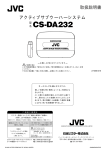


![VadaTech VT85x User Manual[1]](http://vs1.manualzilla.com/store/data/005803212_1-bb50408d9ec4263de47f5dcd2a97e7b3-150x150.png)





